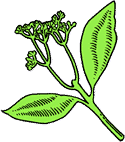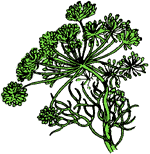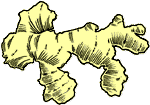New Wave Herbs & Spices


Our cabnets have been enhancing the cooking experience of many since 1970. But herbs and spices have been enhancing the flavor of foods for centuries. Herbs and spices are as ancient as civilization itself, and here's your chance to find out more about them.
Search by Spice |
|
BASIL |  | |
|---|---|---|
| AKA: | Common basil, sweet basil | |
| Native to: | India, Africa, southern Asia | |
| Parts used: | Leaves | |
| Preparation: | The spicy, minty flavor of sweet basil adds character to a variety of ethnic cuisine, from Italian to Thai, and is particularly tasty with tomatoes. For a great recipe that uses basil, click here. | |
| Fun fact: | There are many varieties of basil that you could experiment with in your dishes. Opal basil has a peppery flavor and a dark color; anise basil adds the taste of licorice; then there are lemon and cinnamon basil that are flavored just like their names state. Try your local gourmet food store for these different basils. | |
BAY LEAF | |
|---|---|
| AKA: | Bay laurel, Grecian laurel, sweet laurel |
| Native to: | The Mediterranean |
| Parts used: | Leaf |
| Preparation: | These leaves are widely used in stews, soups and hearty sauces, and can even add nice flavor to the water when boiling potatoes or pasta. Bay leaves should always be added early in the cooking process, as they require a good deal of simmering to release their flavor. But they can hold their shape for hours, and can be easily removed if you desire when the dish is ready to be served. To see a recipe that uses bay leaves, click here. |
| Fun fact: | Though the bay leaf is from a laurel tree, certain laurels should be avoided. Both the mountain laurel and cherry laurel can be potentially lethal. Your best bets are the leaves you'll find in the trusty spice jar at your local grocery store. |
CAPERS | |
|---|---|
| Native to: | Southern Europe, the Mediterranean |
| Parts used: | Flower buds |
| Preparation: | Capers are an ideal addition to sauces and stews, adding a zesty, salty burst of flavor in every biteful. |
| Fun fact: | The caper has baffled many with the question, what is it? Capers are the small flower buds of a small, spiny shrub, picked before they open and cured in a bath of vinegar or a mixture of vinegar and salt. |
CHILI POWDER | |
|---|---|
| Native to: | The American Southwest |
| Preparation: | A combination of mostly cayenne (red) pepper, plus cumin, oregano, salt and garlic powder, chili powder is a spicy ingredient used to flavor chili and fajitas. To enrich the flavor of chili powder, add just a pinch of a sweet spice, like allspice, cinnamon, cloves or onion powder. For a spicy recipe using chili powder, click here. |
| Fun fact: | A little too hot for you? The spiciness of chili powder is oil based, so if you have too much, drinking a glass of water won't help. Instead, try a glass of milk or a beer, as milk and alcohol help to break up the capsaicin (the hot stuff) in the chili powder. |
CINNAMON |  | |
|---|---|---|
| Native to: | Sri Lanka, Sumatra, Borneo | |
| Parts used: | Bark | |
| Preparation: | The taste of cinnamon is recognizable on any tongue. Its warm, sweet fragrance is widely used in everything from rice puddings and fruit pies to ethnic meat dishes and stews. For a tasty recipe using cinnamon, click here. | |
| Fun fact: | Both cinnamon and cassia can be purchased as sticks that look very similar to one another. But there's a way to tell the difference. A true cinnamon stick will resemble a quill with a single tube. A cassia stick is rolled from both sides into the middle. | |
CLOVES | |
|---|---|
| Native to: | East Indies (Indonesia) |
| Parts used: | Flower bud |
| Preparation: | Rarely used on its own, cloves are often combined with other sweet spices such as nutmeg and cinnamon and used in a variety of dishes from desserts to main courses. To try a recipe that uses cloves, click here. |
| Fun fact: | The oil found in cloves is often used to perfume cosmetic items, including toothpaste, soap and body lotion. |
CREAM OF TARTAR | |
|---|---|
| Preparation: | A pinch of cream of tartar added to egg whites before beating will help stabilize the foam. It also prevents the proteins in the white from coagulating (copper ions that flake off a copper bowl during this process do the same thing, that's why many chefs beat egg whites in copper bowls). |
| Fun fact: | Cream of tartar is derived from white crystals found naturally in the lees, or sediment, of grapes that have been fermented in the making of wine. |
CURRY POWDER | |
|---|---|
| Native to: | India |
| Preparation: | Curry powder is actually a conglomeration of 16 to 20 spices, including coriander seed, turmeric, cumin, fenugreek, white pepper, allspice, yellow mustard seed, red pepper and ginger. It forms the basis of the exotic flavors in curry dishes across India and Asia, but has other delightful uses as well. Sprinkle a bit over an apple, then bake it, or heat up applesauce and add a pinch of curry. For a unique way to use curry in a recipe, click here. |
| Fun fact: | Here's
how to make your own curry powder:
In a clean coffee bean grinder, or with a mortar and pestle, grind spices into powder and add to dish in same amounts as indicated for curry powder. This curry recipe can be enhanced with other spices like mustard seeds, saffron, ginger, cloves and cardamom. |
DILL |  | |
|---|---|---|
| Native to: | Europe | |
| Parts used: | Leaves, fruit ("seeds") | |
| Preparation: | While it gives its name to the pickles we all know and love, the light, fragrant taste of dill is ideal for fish and vegetable dishes as well. Try a little in potato salad, or infused into a tomato soup. But don't cook it too long, as it loses its flavor. Find out how to use dill in a recipe by clicking here. | |
| Fun fact: | Dill seeds taste like caraway seeds, and can be used in rye bread. | |
FENNEL | |
|---|---|
| Native to: | Europe, Asia Minor |
| Parts used: | Leaves, dried ripe fruit |
| Preparation: | There many kinds of fennel, such as Florence fennel that can be eaten like celery, and the sweet fennel whose fruit is used as an herb in stuffings, soups and stews. For a recipe that uses fennel, click here. |
| Fun fact: | For something new and different on the grill, add sprigs of fennel to your coals to give fresh grilled fish or chicken a delicate licorice flavor and aroma. |
GINGER |  | |
|---|---|---|
| AKA: | Gingerroot | |
| Native to: | Southern Asia | |
| Parts used: | Root | |
| Preparation: | Always use fresh ginger, and choose only those roots with smooth skin. Ginger should be treated like garlic, as it gets milder when cooked, but bitter when burned. Add it to flavor Asian pork dumplings, or use it in a marinade for fish, or even sprinkle a pinch in your tea to calm a head cold. The pink ginger you find in Japanese restaurants is marinated in lemon juice and salt; the lemon juice turns it pink. You can see a wonderful recipe that uses ginger by clicking here. | |
| Fun fact: | Ginger is actually a distant relative of the banana, and its name is derived from the Latin translation of the Sanskrit word singbera, meaning "shaped like a horn." | |
NUTMEG | |
|---|---|
| AKA: | Myristica |
| Native to: | Indonesia |
| Parts used: | Seed kernel |
| Preparation: | The scent and taste of nutmeg has developed celebratory connotations, as it's a delicate topper for holiday drinks and a fragrant ingredient in special desserts. If using whole nutmeg, keep in mind that one whole grated nutmeg equals 2 to 3 tsps. of ground nutmeg. For a delicious recipe using nutmeg, click here. |
| Fun fact: | Nutmeg, in large doses, can produce a hallucinatory, disoriented effect. High doses can actually be fatal. |
SAFFRON | |
|---|---|
| Native to: | Western Asia, Southern Europe |
| Parts used: | Stigma |
| Preparation: | Saffron is perhaps the dearest seasoning on the planet, so it's a good thing that a little goes a long way to color and flavor soups, rice dishes and stews. Keep saffron in a dark, cool place, as it is highly light sensitive. |
| Fun fact: | Ever wondered why saffron is the world's most expensive spice? It takes 60,000 crocus flowers to yield one pound of saffron. |
THYME | |
|---|---|
| Native to: | Southern Europe |
| Parts used: | Leaves |
| Preparation: | Thyme is an herb that keeps its flavor well when dried. So it's simple to keep in the spice cupboard and use in all kinds of sauces, salads, soups and stews. For a recipe using thyme, click here. |
| Fun fact: | Did you know there are more than 100 different varieties of thyme? They come from all parts of Europe and echo flavors like lemon, nutmeg, pine, mint, even licorice |
Source: The Complete Book of Herbs, Spices & Condiments by Carol Ann Rinzler, Henry Holt & Co., New York, NY, publisher ©1990.